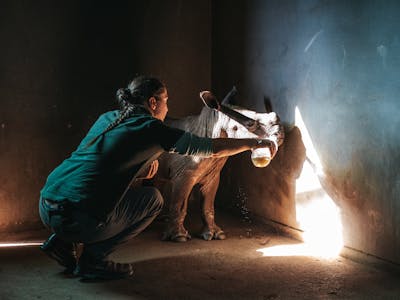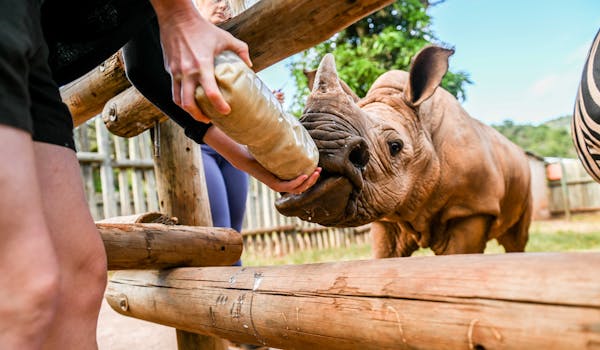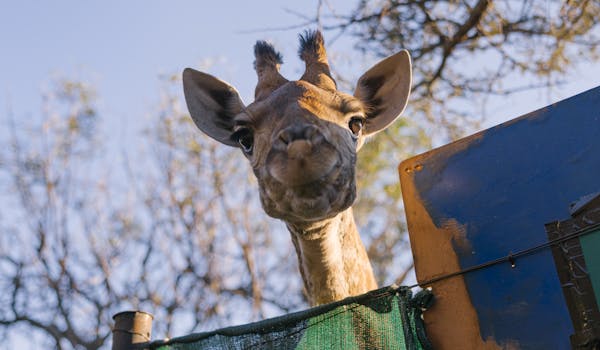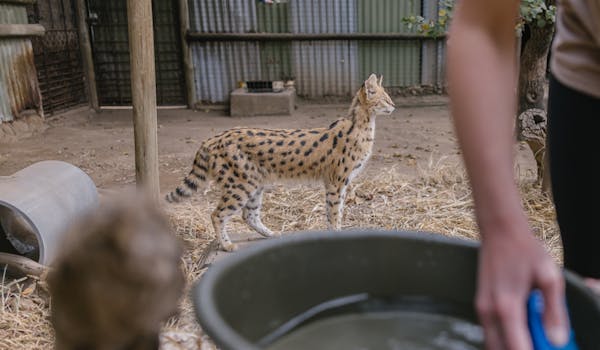Make it yours
Every experience is customised to be just right for you.

Gain hands-on experience caring for orphaned or injured baby rhinos and monitor these beautiful creatures after they’re released into a wildlife reserve. All in the spectacular surroundings of a UNESCO World Heritage Site.
In the morning you could find yourself bottle-feeding an orphaned baby rhino as it starts its rehabilitation journey. In the afternoon you might be surrounded by wildebeest and zebras while monitoring rhinos in the wild. By night you could find yourself preparing a meal with your fellow volunteers and discussing the day's activities.
With one-on-one supervision from a team of expert zoologists, conservationists and researchers, you’ll be actively involved and learning about every detail of rhino care and rehabilitation.



From bottle-feeding orphaned calves to helping monitor adult rhinos after they’re released back into the wild, Golola gives you the chance to see and learn about vital stages of rhino rehabilitation.
You’ll live and work alongside Golola’s highly qualified and passionate team, led by an experienced zoologist specialising in rhinos. As part of this small team, you’ll pick up unique insights into the project’s research to ensure rhinos are rehabilitated successfully.
Through a series of lectures and educational bushwalks, you’ll learn about rhino rehabilitation, broader conservation topics, different species living in the region and bushcraft skills. This is a unique learning experience that goes far beyond rhinos.
Established in 2012, Golola is situated close to a large number of national parks and private reserves where rhinos are targeted by poachers. Without government funding, they rely on volunteers like you to continue their vital work safeguarding the area’s threatened rhinos.
Golola is set in a World Heritage Site home to giraffes, zebra, warthogs, and elusive leopards. After a rhino is released into this incredible natural environment, you’ll help monitor their health and behaviour to ensure they adapt successfully to their new habitat.
Golola aims to establish a viable breeding rhino population on the reserve. The project’s research into how they’re making this a reality is being shared with other conservationists, helping secure a future for rhinos across Africa.
Living and working as part of the project team, you’ll have the chance to share stories and learn about rhinos from experts in a unique setting. Or simply sit back and marvel at the stars painted across the African night sky.
You’ll support the project team with a variety of rhino care and monitoring activities. Depending on the centre’s priorities and the animals’ welfare needs at the time, this will include a range of the following responsibilities.
Many rhinos are injured and emotionally distressed on arrival at the project. As part of a professional and passionate team, you’ll help care for and rehabilitate rhinos so they can eventually be released back into the wild.
You will get to assist:
You could also observe or assist:
The project staff will give you detailed lectures on how to hand-rear rhinos so you’re ready to help with this important work. If there are baby rhinos at the centre during your stay, you will get to observe or assist:
Once they’re old enough, the rehabilitated rhinos are released into the surrounding wildlife reserve which is part of a UNESCO World Heritage Site. Monitoring the rehabilitated rhinos on a daily basis is another key part of rhino conservation work at this project.
You will get to observe or assist:
You could also observe:
Education is a big part of project life. As well as formal and informal talks, you’ll also accompany staff on educational bush walks. During these sessions, they’ll give you insights into a wide range of relevant topics.
You will gain insights into:
If veterinary work is required, specialist wildlife veterinarians or vet nurses will visit the centre and perform procedures in the ICU rooms or out in the field. Depending on your skill level and the needs of the project, you could observe or assist:
You’ll learn about the care and rehabilitation of rhinos, as well as their behaviour, biology, ecology, and conservation issues. Depending on the animals being cared for and the centre’s work at the time, this will include a range of the following topics.
This project contributes to a variety of the UN’s Sustainable Development Goals. As part of the team, so will you.
The content of this publication has not been approved by the United Nations and does not reflect the views of the United Nations or its officials or Member States.

Volunteers at Golola learn relevant skills for rhino care and rehabilitation using the project’s on-site education facilities. All learners at Golola acquire knowledge on how human actions can affect wildlife and how they can minimise this effect - and have access to the same standard of education regardless of sex and background.

Golola provides equal employment opportunities and women hold key leadership and decision-making roles. The project also offers equal volunteering opportunities for women and men from outside the local community.

Golola achieves access to safe and affordable drinking water by using boreholes to pump water from underground aquifers.

Golola has implemented a modern solar energy system to power the centre efficiently and sustainably.

Golola routinely employs young people between 15 and 24 and provides equal employment opportunities for local men and women. Volunteers provide both economic and physical support, facilitating important rhino conservation work.

Through the financial support generated by self-funded international volunteers, Golola has been able to implement a solar energy system that powers the project - thereby helping implement sustainable, off-grid energy systems at the project site.

Golola builds sustainable and resilient buildings using materials that are locally sourced from within South Africa. The project also protects the world’s natural heritage through the conservation of iconic African species, the black and white rhino.

Golola promotes responsible tourism in a variety of ways: through the creation of local jobs; by educating international and local visitors how to live in harmony with nature; and in its vital conservation work.

Golola takes urgent action to halt biodiversity loss and prevent the extinction of threatened species. By rescuing and rehabilitating black and white rhino, the project prevents the degradation of ecosystems in which these species play a crucial ecological role. The reserve surrounding the centre is a protected habitat where flora and fauna are allowed to flourish.
Golola also takes urgent action to prevent poaching, by employing a highly skilled anti-poaching unit to protect the rhinos at the centre and in the wider reserve.

Golola employs an expert team of anti-poaching officers, who patrol the reserve to combat and deter poachers and reduce the unethical practices associated with their activities.

Through Golola’s partnership with us, they draw in financial resources that are used to fund conservation and provide support to their community partners in South Africa.
Related experiences
Explore programs similar to this one.

Help save the rhino at the largest specialist rhino care centre in Africa
View details for Care For Wild Africa Rhino Sanctuary
Help care for injured and endangered wildlife in a dedicated rehabilitation centre
View details for Moholoholo Wildlife Rehabilitation Centre
Make a meaningful difference at two of South Africa's most respected wildlife rehabilitation centres
View details for The Immersive Wildlife Rehabilitation Experience